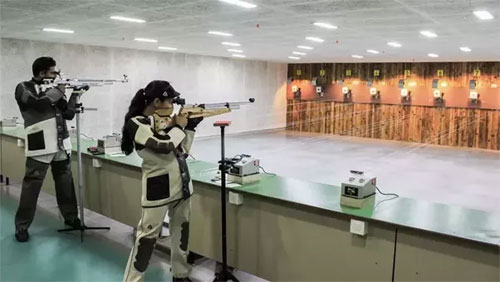Raging Against Self Defense: Psychiatrist Examines the Anti-Gun Mentality (3)
By Sarah Thompson, M.D.
Read the second part of the article

Reversing Irrational Thoughts
The Mirror Technique
One approach that can be helpful is simply to feed back what the anti-gun person is telling you, in a neutral, inquisitive way. So, when replying to my anonymous e-mail correspondent, I might respond: “So you fear if your neighbors had guns, they would use them to murder you. What makes you think that?” When you simply repeat what the person has said, and ask questions, you are not directly challenging his defenses. You are holding up a mirror to let him see his own views. If he has very strong defenses, he can continue to insist that his neighbors want to murder him. However, if his defenses are less rigid, he may start to question his position.
Another example might be: “Why do you think that your children’s schoolteachers would shoot them?”. You might follow this up with something like: “Why do you entrust your precious children to someone you believe would murder them?” Again, you are merely asking questions, and not directly attacking the person or his defenses.
Of course the anti-gun person might continue to insist that the teachers really would harm children, but prohibiting them from owning guns would prevent it. So you might ask how using a gun to murder innocent children is different from stabbing children with scissors, assaulting them with baseball bats, or poisoning the milk and cookies. It’s important to ask open-ended questions that require a response other than “yes” or “no”. Such questions require the anti-gun person actually to think about what he is saying. This will help him to re-examine his beliefs. It may also encourage him to ask you questions about firearms use and ownership.
The “What Would You Do?” Technique
Once you have a dialogue going with an anti-gun person, you might want to insert him into a hypothetical scenario, although doing so is a greater threat to his defenses, and is therefore more risky. You might ask how he would deal with a difficult or annoying co-worker. He will likely respond that he would never resort to violence, but “other people” would, especially if they had guns (projection again). You can then ask him who these “other people” are, why they would shoot a co-worker, and what the shooter would gain by doing so.
Don’t try to “win” the argument. Don’t try to embarrass the person you’re trying to educate. Remember that no one likes to admit that his deeply held beliefs are wrong. No one likes to hear “I told you so!”
Be patient and gentle. If you are arrogant, condescending, hurtful or rude to the anti-gun person, you will only convince him that gun owners are arrogant, hurtful people – who should not be trusted with guns!
Defusing Emotional Reactions
The “You Are There” Technique
Rational arguments alone are not likely to be successful, especially since many people feel rather than think. You also need to deal with the emotional responses of the anti-gun person. Remember that most people have been conditioned to associate firearms with dead toddlers. So you need to change the person’s emotional responses along with his thoughts.
One way to do this is to put the anti-gun person (or his family) at a hypothetical crime scene and ask what he would like to have happen. For example: “Imagine your wife is in the parking lot at the supermarket and two men grab her. One holds a knife to her throat while the other tears her clothes off. If I see this happening and have a gun, what should I do? What would happen next? What if, after five minutes, the police still haven’t arrived?” (In this article, the author is addressing the American public – editor’s note).
Just let him answer the questions and mentally walk through the scenario. Don’t argue with his answers. You are planting seeds in his mind than can help change his emotional responses.
The power of Empathy
Another emotion-based approach that is often more successful is to respond sympathetically to the plight of the anti-gun person.
Imagine for a moment how you would feel if you believed your neighbors and co-workers wanted to kill you and your family, and you could do nothing at all about it except to wait for the inevitable to occur.
Not very pleasant, is it?
This is the world in which opponents of armed self-defense live. All of us have had times in our lives when we felt “different” and had to contend with hostile schoolmates, co-workers, etc. So we need to invoke our own compassion for these terrified people. Say something like: “It must be awful to live in fear of being assaulted by your own neighbors. I remember what it was like when I was the only (Jew, Mormon, African-American, Republican) in my (class, football team, workplace) – and even then I didn’t think anyone was going to kill me.” It’s essential that you sincerely feel some compassion and empathy; if you’re glib or sarcastic, this won’t work.

Using empathy works in several ways. First, it defuses a potentially hostile interaction. Anti-gun people are used to being attacked, not understood, by advocates of gun rights. Instead of an “evil, gun-toting extremist”, you are now a sympathetic, fellow human being. This may also open the door for a friendly conversation, in which you can each discover that your opponent is a person with whom you have some things in common. You may even create an opportunity to dispel some of the misinformation about firearms and self-defense that is so prevalent.
This empathy technique is also useful for redirecting, or ending, a heated argument that has become hostile and unproductive. It allows you to escape from the dead end of “guns save lives” vs. “the only reason to have a gun is to murder children”. With empathy you can reframe the argument entirely. Instead of arguing about whether more lives are saved or lost as a result of gun ownership, you can comment on how terrifying it must be to live in a country where 80 million people own guns “solely for the purpose of murdering children”.
You should not expect any of these approaches to work immediately; they won’t. With rare exceptions, the anti-gun person is simply not going to “see the light”, thank you profusely, and beg you to take him shooting. What you are doing is putting tiny chinks into the armor of the person’s defenses, or planting seeds that may someday develop into a more open mind or a more rational analysis. This process can take months or years. But it does work!
Corrective Experiences
Perhaps the most effective way to dissolve defense mechanisms, however, is by providing corrective experiences. Corrective experiences are experiences that allow a person to learn that his ideas about gun owners and guns are incorrect in a safe and non-threatening way. To provide a corrective experience, you first allow the person to attempt to project his incorrect ideas onto you. Then, you demonstrate that he is wrong by your behavior, not by arguing.
For example, the anti-gun person will unconsciously attempt to provoke you by claiming that gun owners are uneducated “rednecks”, or by treating you as if you are an uneducated “redneck”. If you get angry and respond by calling him a “stupid, liberal, socialist”, you will prove his point. However, if you casually talk about your M.B.A., your trip to the Shakespeare festival, your vegetable garden, or your daughter’s ballet recital, you will provide him with the opportunity to correct his misconceptions.
If you have used the above techniques, then you have already provided one corrective experience. You have demonstrated to the frightened anti-gun person that gun owners are not abusive, scary, dangerous and sub-human monsters, but normal, everyday people who care about their families, friends and even strangers.
As many gun owners have already discovered, the most important corrective experiences involve actually exposing the fearful person to a firearm. It is almost never advisable to tell someone that you carry a concealed firearm, but there are ways to use your own experience favorably.
For example, if you’re dealing with an anti-gun person with whom you interact regularly and have a generally good relationship – a coworker, neighbor, church member etc. – you might indirectly refer to concealed carry. You should never say anything like “I’m carrying a gun right now and you can’t even tell”, especially because in some states that would be considered illegal, threatening behavior. But you might consider saying something like: “I sometimes carry a firearm, and you’ve never seemed to be uncomfortable around me”. Whether to disclose this information is an individual decision, and you should consider carefully other consequences before using this approach.
First-hand experience
Ultimately, your goal is to take the anti-gun person shooting. Some people will accept an invitation to accompany you to the range, but others are too frightened to do so, and will need some preliminary experience.
First, you want to encourage the anti-gun person to have some contact with a firearm in whatever way feels most comfortable to him. Many people seem to believe that firearms have minds of their own and shoot people of their own volition. So you might want to start by inviting him simply to look at and then handle an unloaded firearm. This also provides you the opportunity to show the inexperienced person how to tell whether a firearm is loaded and to teach him the basic rules of firearms safety.
Encourage the newcomer to ask questions and remember that your role is to present accurate information in a friendly, responsible and non-threatening way. This is a good time to offer some reading material on the benefits of firearms ownership. But be careful not to provide so much information that it’s overwhelming. And remember this is not the time to launch into anti-government rants, the New World Order, conspiracy theories, or any kind of political talk!
Next, you can invite your friend to accompany you to the shooting range. (And if you’re going to trust each other with loaded guns, you should consider yourselves friends!) Assure him that no one will force him to shoot a gun and he’s free just to watch. Let him know in advance what he will experience and what will be expected of him. This includes such things as the need for eye and ear protection, a cap, appropriate clothing, etc. Make sure you have a firearm appropriate for your guest should she/he decide to try shooting. This means a lower caliber firearm that doesn’t have too much recoil. If your guest is a woman, make sure the firearm will fit her appropriately. Many rifles have stocks that are too long for small women, and double-stack semi-autos are usually too large for a woman’s hand.

Remember that just visiting the range can be a corrective experience. Your guest will learn that gun owners are disciplined, responsible, safety-conscious, courteous, considerate, and follow the rules. He will see people of all ages, from children to the elderly, male and female, enjoying an activity together. He will not see a single “beer-swilling redneck” waving a firearm in people’s faces.
In my experience, most people who visit a range will decide they do want to try shooting. Remember to make sure your guest understands all the safety rules and range rules before allowing him to handle a firearm. If you don’t feel competent to teach a newcomer to shoot, ask an instructor or range master to assist. Remember to provide lots of positive feedback and encouragement. If you’re lucky, you’ll recruit a new firearms enthusiast.
But even if your guest decides that shooting is not for him, he will have learned many valuable lessons. He will know basic rules of firearms safety, and how to clear a firearm should he need to do so. This may well save his life someday. He will know that guns do not fire unless a person pulls the trigger. He will know that gun owners are friendly, responsible people, not very different from him. Even if he chooses not to fire a gun ever again, he will be less likely to fear and persecute gun owners. And who knows – a few months or years later he may decide to become a gun owner.
Why these techniques do not always work
You should remember that you will not be successful with all anti-gun people. Some people are so terrified and have such strong defenses, that it’s not possible for someone without professional training to get through. Some people have their minds made up and refuse to consider opening them. Others may concede that what you say “makes sense”, but are unwilling to challenge the forces of political correctness. A few may have had traumatic experiences with firearms from which they have not recovered.
You will also not be successful with the anti-gun ideologues, people like Charles Schumer and Dianne Feinstein. These people have made a conscious choice to oppose firearms ownership and self-defense. They almost always gain power, prestige, and money from their anti-gun politics. They are not interested in the facts or in saving lives. They know the facts and understand the consequences of their actions, and will happily sacrifice innocent people if it furthers their selfish agenda. Do not use these techniques on such people. They only respond to fears of losing the power, prestige and money that they covet.
Conclusion
By better understanding advocates of civilian disarmament, and by learning and practicing some simple techniques to deal with their psychological defenses, you will be much more effective in your efforts to communicate with anti-gun people. This will enable you to be more successful at educating them about the realities of firearms and self-defense, and their importance to our liberty and safety.
Educating others about firearms is hard work. It’s not glamorous, and it generally needs to be done one person at a time. But it’s a very necessary and important task. The average American supports freedom of speech and freedom of religion, whether or not he chooses to exercise them. He supports fair trials, whether or not he’s ever been in a courtroom. He likewise needs to understand that self-defense is an essential right, whether or not he chooses to own or carry a gun.
yogaesoteric
September 16, 2018
Also available in:
 Français
Français
